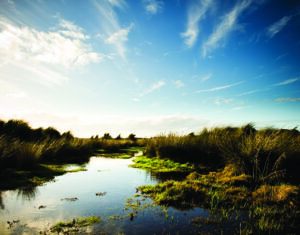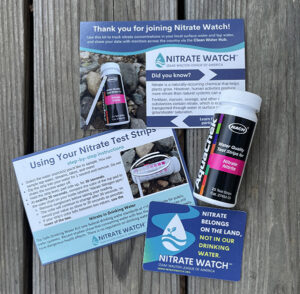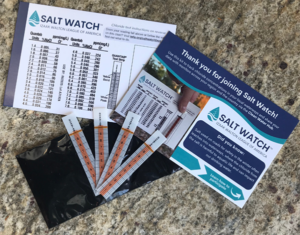Across the United States, roughly 900 million acres of private land are used for agriculture. The way our nation’s farms and ranches are managed impacts all of us—the food we eat, the water we drink and the resilience of our communities against flooding and natural disasters.
American farmers feed, fuel, and clothe the country and the world. At the same time, agriculture is the single largest source of runoff polluting our drinking water, streams and lakes, putting human health at risk. Our nation’s soils are being eroded and degraded, putting us on track for another Dust Bowl. Vital wetlands and grassland are being converted for agriculture at unsustainable rates.
These problems are serious and persistent—and we’re running out of time to address them. The good news is that we can make progress, and conservation holds the key. Our priority is scaling up conservation practices from planting cover crops, to reducing tillage, to placing buffer strips along streams across tens of millions of acres of farmland nationwide. If more of American agriculture used best practices and prioritized conservation, we would:
- Have cleaner, safer drinking water for human consumption.
- Keep precious topsoil in the field where we need it to feed future generations.
- Fight climate change by keeping carbon in the soil.
- Increase available habitat for fish and wildlife.
- Improve the bottom line for family farmers who cut costs by using less fertilizer, pesticides, diesel fuel and more.
Our Work at the League
The Izaak Walton League of America is a leader on these issues and more. Our work to advance conservation on agricultural lands includes:
- Advocating for federal policy that will spur conservation adoption and reduce roadblocks to good behavior. Click here to learn more about our work on the Farm Bill.
- Educating farmland owners about the importance of prioritizing conservation on their land.
- Volunteer water monitoring to track trends in our waterways—particularly nitrate, which is largely attributable to agricultural sources. Click here for information about our Nitrate Watch program.

The Problems We Face Are Well-Documented and Not New
Water Pollution
When farms are not managed with conservation in mind, agricultural fertilizers and manure commonly wash off land and into waterways, eventually ending up in our drinking water. These pollutants—including nutrients like nitrate and phosphorus, and pathogens like e coli—pose serious threats to human health. Nitrate, for example, increases the risk of conditions including colorectal cancer, thyroid disease and neural tube defects, such as spina bifida. In lakes and streams, nutrients from agriculture also cause algal blooms which are dangerous to both humans and wildlife.
Click here to read more about the League’s work on clean water.
Soil Erosion and Degradation
The food we all eat depends on just a few inches of precious topsoil to grow. Yet, conventional farming methods make soil vulnerable to erosion, and our topsoil is being eroded more than three times faster than it can be replaced. Experts say we are on track for another Dust Bowl. These conditions put our entire food supply, economy, and national security at risk, as well as making the food that we eat every day less nutritious.
Click here to learn more about soil health practices and their potential to mitigate climate change.
Accelerating Climate Change
Agricultural lands offer one tool in the all-of-the-above effort required to address the climate crisis. While we work to reduce greenhouse gas emissions, we also need to store more carbon in natural sinks. Cropland accounts for one fifth of the land mass in the United States. Better management of that land can sequester up to one metric ton of carbon per acre per year. The average farm is roughly 460 acres, and if managed properly, could offset the emissions of roughly 100 cars.
Click here to learn more about the League’s priorities on climate change.
Loss of Vital Wetlands
Wetlands play an essential role in filtering and improving water quality, absorbing floodwaters, and providing habitat for fish and wildlife. Yet, they are being drained for agricultural purposes at alarming rates. In fact, we lose almost an acre of wetlands every six minutes. Worse, in 2023, the Supreme Court made the single largest rollback of clean water protections in 50 years, deciding that the Clean Water Act does not protect most of the nation’s wetlands and millions of miles of streams, putting an even bigger target on our remaining wetlands.
Click here to learn more about the implications of the decision.
Wildlife Habitat Loss
Quality habitat for fish and wildlife is under threat. More than a third of the nation’s plants and animals are at risk of becoming threatened or endangered and habitat loss is the primary driver of these declines. Numerous species are showing the effects—for example, there are three billion fewer birds in the U.S. and Canada than in 1970.
Click here to learn more about the League’s work to bolster wildlife habitat.

 Your kit will include a bottle containing 25 nitrate test strips which you can use to test your water source(s) throughout the year. You’ll also receive postcards explaining how to use your nitrate test strips and how to share your Nitrate Watch results on the Clean Water Hub.
Your kit will include a bottle containing 25 nitrate test strips which you can use to test your water source(s) throughout the year. You’ll also receive postcards explaining how to use your nitrate test strips and how to share your Nitrate Watch results on the Clean Water Hub. Your kit will include four test strips so you can test your waterway throughout the season. You’ll also receive a chart to help you interpret your results and a postcard with instructions for completing a Salt Watch test and reporting your findings.
Your kit will include four test strips so you can test your waterway throughout the season. You’ll also receive a chart to help you interpret your results and a postcard with instructions for completing a Salt Watch test and reporting your findings.